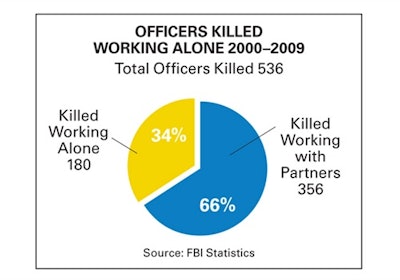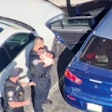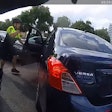
Each year the FBI compiles a special report on law enforcement officers killed and assaulted (LEOKA). Although it's a grim topic, much can be learned about the behavior of cop killers and the cops who are feloniously killed by analyzing the source data.
The following is a quick look at some of the issues raised by the last decade of LEOKA reports. But fundamentally, it's a picture of what gets cops killed.
In Groups and Alone
It goes against conventional wisdom, but from 2000 to 2009, nearly twice as many police officers were killed in the company of partners and with backup than were killed alone.
FBI stats for the last decade show that 180 officers were killed acting alone while 356 were killed working with other officers. Off-duty attacks claimed 50 of these officers.
One of three types of incidents is most likely to end with an officer down: disturbances, arrests, and traffic stops.
Disturbances, including such things as bar fights, reports of a person with a firearm, and domestics, resulted in 77 murdered officers from 2000 to 2009. Arrests, including attempted arrests and pursuits, resulted in 121 officers feloniously killed.
As most officers would expect, traffic stops are also extremely dangerous. A total of 101 officers were murdered during traffic stops from 2000 to 2009. Thirty-six of these officers were killed during felony traffic stops.
Alarmingly, ambushes were another major cause of death for officers during the decade in question. Premeditated entrapment attacks killed 42 officers, while sudden unprovoked assaults killed another 73.
Time of Day Matters
According to the FBI statistics, the safest time to be on patrol is from 6:01 a.m. to 8 a.m. From 2000 to 2009, just three percent of all officer murders occurred during this two-hour period. Felonious killings of officers are also less likely from 2:01 to 6 in the morning. About 11 percent of police murders occur during this four-hour period. With just 21 percent of officer murders occuring from 2:01 a.m. to 10 a.m., it appears that bad guys go to bed and stay in bed during that eight-hour cycle.
The deadliest time to be out on the job, according to the decade of FBI stats, is from 8:01 p.m. to 10 p.m. Some 14 percent of all police murders occur in this two-hour period.
And as most cops would probably predict, the hours of 8:01 p.m. to 2 a.m-when the bars are open and just after they close in most jurisdictions-are also particularly dangerous for law enforcement. In the last decade, 195 officers were killed during that six-hour span, some 36 percent of the total body count.
This does not mean that daylight hours are necessarily safe. In the last decade, 38 percent of all officers feloniously killed were attacked between the hours of 8:01 a.m. and 6 p.m.
Guns and Other Weapons
America is a gun culture. There are other places on this planet where police have to worry more about knives or clubs or bombs, but here in the United States the vast majority of law enforcement officers murdered fall prey to assailants armed with firearms.
In the last decade, 490 American officers were feloniously killed with guns. That's a whopping 91 percent of all officers murdered in the line of duty.
Handguns remain the tool of choice for cop killers. A total of 357 officers were killed with pistols during the last decade. That's 67 percent of the total number of officers killed and 73 percent of all gun murders of officers.[PAGEBREAK]
Rifles were also particularly devastating weapons in the hands of cop killers. Rifles can easily defeat most law enforcement body armor, so a rise in rifle attacks would be particularly alarming. Rifle murders of officers had been trending down since 2004 when 13 officers were killed with rifles. But they spiked in 2009, claiming 15 officers' lives. In total, 94 officers were shot and killed with rifles in the last decade, accounting for 19 percent of all firearm murders of officers and 17 percent of all felonious cop killings.
Edged weapons are very unlikely to be used in a cop killing in the U.S. This does not mean that cops aren't attacked with knives; they certainly are. But it does mean that these weapons are not as lethal or as commonly used in attacks on officers as guns. In the last decade, three officers were killed with blades.
A much more likely non-firearm weapon for a cop killing than a knife is a car or truck. From 2000 to 2009, 38 officers were intentionally killed by people who targeted them with motor vehicles. That's just seven percent of all cop killings during the last decade, but it's 83 percent of all non-firearm murders of officers.
Note: The FBI statistics for officers killed from 2000 to 2009 do not include the 72 officers killed in the 9/11 terror attacks of 2001.
Mortal Wounds
The FBI statistics for the last decade do not reveal any clear trends on shot placement by cop killers.
However, the vast majority of fatal wounds inflicted on officers appear to be head shots, 243 out of 490, nearly 50 percent. The reason that this is so is not readily clear. Head shots are generally more lethal than body shots, so it stands to reason that a large number of officers killed by firearms would be hit in the head.
Fortunately, there does not appear to be a growing trend among cop killers to aim for the head. In 2001, 34 officers were killed by head shots. This number dropped to 29 the next year, 19 in 2003, and 18 in 2008. In 2009, the last year measured, 23 officers were killed by head shots.
The prevalence of head wounds in the FBI statistics is clear, but cops are also still falling from chest wounds. In the last decade, 135 officers were killed by bullets to the chest, accounting for 28 percent of all fatal firearms wounds among officers.
As with head wounds, there appears to be no trend in the prevalence of chest wounds in the killing of officers. In 2004, 19 officers were killed by gunshot wounds to the chest. This number dropped to 14 in 2005 and 11 in 2006. But it climbed back up to 19 in 2007 before dropping to seven in 2008 and leveling off at 11 in 2009.
Armor On or Off
The statistics on chest shots raise questions of body armor use by the fallen officers. But just because an officer was killed by a shot to the chest does not necessarily mean that he or she was working without a vest. Some officers are killed undercover, in plain clothes, and even off duty. Also, some officers wearing armor are killed by chest shots that overwhelm the armor such as rifle fire.
Unfortunately, the FBI stats do not drill down deep enough into this issue. They merely list whether officers were wearing armor at the time of their murders.
Out of 536 officers feloniously killed from 2000 to 2009, 341 were wearing armor. That's a solid 63 percent, and even 36 officers who were killed out of uniform were wearing armor.


















